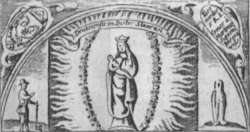D r u ž e c n e a r K l a d n o
50°06´11,25´´n. l.; 14°02´45,96´´e. l.; 375 m
Documented Milavenian period along with Slav skeleton graves; possibly the Boies passed through here from Mze River to Msecke Zehrovice. Since 14th century the majority of its part belonged to Krivoklat Castle; Bohemian kings executed their forwarding (registration) right here; it was a royal estate. From the year 1636 it was the patron of the Church of Charles IV. In 1466 the king George of Podebrady donated Druzec to Borita from Martinice; the sign of Martinic Clan can bee seen on the Church-i.e. eight-tailed star. Druzec used to be a pilgrimage place, along the ways to the church there were baroque statues of saints. The Gothic Marian statue made of wood 90 cm high is quite interesting, the statue used to be considered miraculous in the past. First mention of Druzec dates y. 1320; royal provincial writer Zdislav from Dobra obtained Dobra and Druzec at that time.
Clergyman Zelenka tells a story about the statue in his report put forward to the consistory in 1677: There is a miraculous statue of Virgin Mary inside Druzec parish church that many people obtain great mercies and blessings therefrom. It has been said she had been miraculous already before Zizka era and this because Zizka the chieftain burnt the church in a fire during Hussite Wars with the statue remaining intact inside the fire. However I do not find any written documents about this event since the parsonage was burnt out during the war with all its books either lost or burned down.

A folk legend links this ancient statue with a petrification, i.e. a stone block of the size and unspecified resemblance (shape) of a grown-up man now standing to the right of the church front (facade). In the book released in Prague in 1690 under a title Via Sancta Praga Vetero.- Boleslaviam ad Dei Genitricem deducens we can read about Druzec Mary Statue as well as about the petrification as follows:
The statue of Virgin Mary in Druzec remained intact in the middle of the flames when the entire Druzec church was destroyed by the fire. There a perjurious man when swearing by a thing (conjuring) to be altered into a rock, was petrified instantly. Cujus imago Druzecii a flammis intacta permansit, cum interea tora Druzecensis Ecclesia iis absumeretur, et ubi homo perjurus, sibi, ut in saxum verteretur, imprecatus, mox in lapidem obriguit.
In the same book there is little engraving depicting in the middle a little statue of Druzec, and a Petrification in the right.
Clergyman Frantisek Adam Cink (1745-51) recounts in his memory book:
"In front of the parish church on its left side a stone column can be found, into which a man - oathbreaker and blasphemer against Blessed Virgin was changed. No information found on when it happed; however the statue of Virgin Mary of Druzec on the oldest pictures is always depicted there as standing there with this column. One scholarly and in literature proficient and experienced man told me he possesses a listing relating to this column and he promised to lend it to me, but he had died before he could have had met his promise."

In the colletion of engravings of Strahov canony in Prague a woodcut from XVIIIth century has been preserved on which high in the sky we see Virgin Mary of Druzec, down in front of the church there is a petrification of a man. Below the picture the following Latin signature has been printed :
Miraculosa statua B. Virginis in Druschetz Dom. Smetznae Districtu Slanensis;
and on the second side the printing says:
Nábožná modlidba k nejblahoslavenější Panně Marii, která se ve farním chrámu Páně Družeckém, v kraji Rakovnickém, od nepamětlivých časů sobotního dne vykonává
( Religious prayer to the most blessed Virgin Mary that has been carried out on Saturdays in the parish cathedral of Druschetz Dominical, within the Rakovnik region, ever since time immemorial).
( The text of the prayer in the copy preserved is not complete since only the first sheet of the print containing maybe two or three sheets has been maintained).
Clergyman Frantisek Klinkacek arranged for letting a shingle shed (canopy) to be made in 1777 over the petrified man.
Anno 1777 post Ecclesiam hominem in lapidem versum,
uti decitur, per meam industruam sine impensis ecclesiae scandulis tegi curavi.
A wooden board used to hang on the petrification complete with the inscription in Czech-Latin-German: Falešně přísahající člověk zde v kámen obrácen jest.
Perjurus homo hic in lapidem versus est. Ein falsch Eid Schworender Mensch ist allhier in Stein worden.
(Perjuriouslyswearing man turned into a stone overhere).

Clergyman Kubista points on this matter in his parish memory book:
It is well known that during previous centuries some man had been proved guilty of falsely swearing (raping); following his death the corpse of him was not buried on the graveyard but outside instead.
It became a habit to erect a huge stone on his tomb to indicate a dead body of the oathbreaker was lying thereunder. Later on a proverb petrified himself (zkamenel se) came to life based on this.
The story has been told similarly by Weininger in the magazine called Časopis katol. duchov. 1830, 402.

Originally it stood round 30 m south of the church and in 1856 was moved to the right side of the major entrance and leaned against the corner of graveyard wall.
It is a fine-grained white-grey cobblestone along with little boulders (nuggets)
Height 1,8 m and 800 kg mass.


